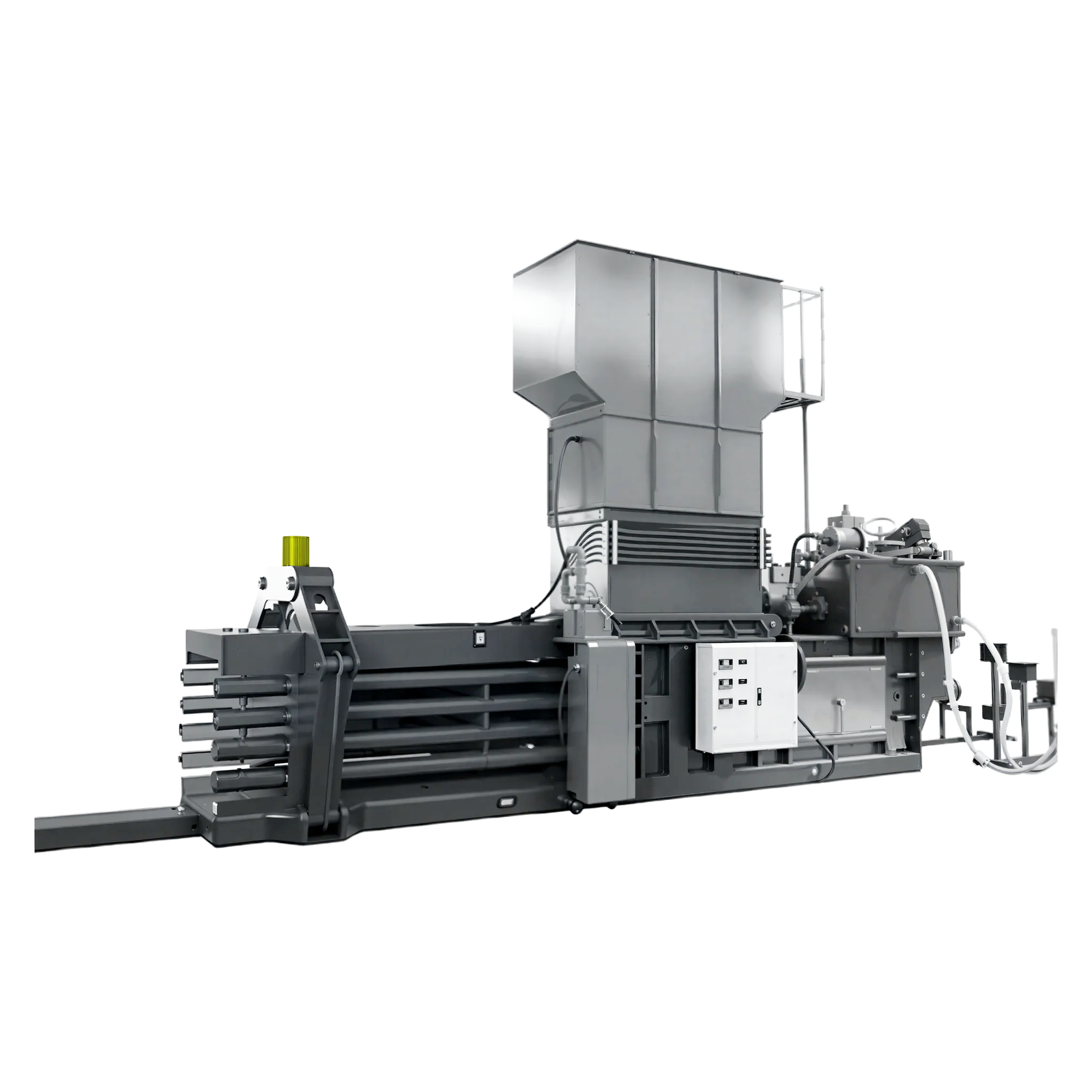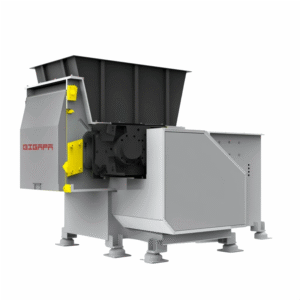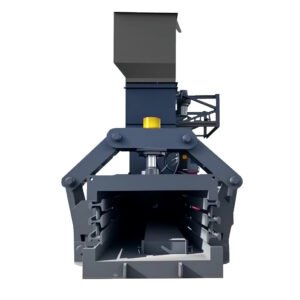In the bustling world of recycling, waste management, and industrial processing, managing bulky materials efficiently is a constant challenge. Enter the hydraulic press baler – a powerful and indispensable machine whose core function is high-density compaction. While this sounds straightforward, the implications and benefits of this primary function ripple outwards, driving operational efficiency, cost savings, and environmental sustainability across numerous industries. This article delves deep into the workings and multifaceted value of the hydraulic press baler.
Defining the Machine: Power at its Core
At its most fundamental level, a hydraulic press baler is a machine designed to compress loose, bulky materials into compact, dense, and manageable blocks or bales. It achieves this through the immense force generated by a hydraulic system.
- Hydraulic Power: The heart of the machine. A hydraulic pump pressurizes hydraulic fluid (oil), which is then directed through valves into hydraulic cylinders.
- Immense Force Generation: The pressurized fluid acts on pistons inside the cylinders. Due to the fundamental principle of hydraulics (Pascal’s Law: Pressure applied to a confined fluid is transmitted undiminished), even a relatively small pump can generate enormous force when acting on a large piston surface area. This force is measured in tons (e.g., 10-ton, 30-ton, 100-ton, or even higher capacity balers).
- The Platen (Ram): The piston rod is connected to a large, sturdy plate called the platen or ram. This is the component that physically presses down onto the material.
- Baling Chamber: Material is loaded into a chamber or box. The platen moves within this chamber to compress the material against a fixed wall or another moving platen.
- Bale Tying/Ejection: Once maximum compression is achieved, wires, straps, or twine are automatically or manually applied to secure the bale. The baler then ejects the dense, tightly bound package.

The Main Function: High-Density Compaction – Why It Matters
The primary and defining function of every hydraulic press baler is to apply this immense hydraulic force to drastically reduce the volume of loose materials. This seemingly simple act of compaction delivers profound benefits:
-
Massive Volume Reduction: This is the most immediate and visually apparent outcome. Bulky materials like cardboard, plastic film, paper, textiles, aluminum cans, or even non-ferrous metals can be compressed to a fraction of their original loose volume. Reductions of 10:1, 20:1, or even higher ratios are common.
-
Impact: Frees up crucial floor space in warehouses, recycling facilities, and manufacturing plants. Significantly reduces the frequency of waste pickups, lowering hauling costs. Allows for much more material to be stored or transported in the same physical space.
-
-
Creation of Dense, Uniform Bales: The hydraulic force doesn’t just squish material; it creates a dense, solid, and stable block. This uniformity is key for downstream handling.
-
Impact: Bales are stackable, maximizing vertical storage space. They are stable and secure for transport, minimizing shifting or collapse during trucking or shipping, enhancing safety and logistics efficiency. Uniform bales are essential for automated handling systems and fetch better prices in recycling markets.
-
-
Material Handling Optimization: Loose material is notoriously difficult, time-consuming, and potentially hazardous to handle. Think of piles of cardboard boxes or tangled plastic film.
-
Impact: Bales transform chaotic, unwieldy material into neat, standardized units. This dramatically speeds up loading/unloading, reduces manual labor requirements, minimizes worker exposure to dust and potential injuries associated with handling loose scrap, and integrates smoothly with forklifts and conveyor systems.
-
-
Enhanced Safety: Reducing loose material piles inherently reduces risks like fire hazards (less air space within the pile), trip hazards, and unstable piles collapsing.
-
Impact: Creates a cleaner, more organized, and inherently safer working environment. Compacting materials like oily rags or certain textiles can also mitigate specific fire risks.
-
-
Economic Efficiency: The benefits above translate directly to the bottom line:
-
Reduced Hauling Costs: Fewer trips needed for waste removal or material shipment.
-
Reduced Storage Costs: More material stored in less space.
-
Increased Revenue (Recycling): Dense, clean, well-formed bales command significantly higher prices from recyclers and mills compared to loose material. Contamination is also easier to control.
-
Lower Labor Costs: Faster, easier handling and reduced manual effort.
-
Reduced Disposal Fees: Less volume going to landfill means lower tipping fees.
-
-
Environmental Sustainability: Efficient compaction is inherently greener:
- Reduced Transportation Footprint: Fewer truck trips mean lower fuel consumption and greenhouse gas emissions.
- Landfill Diversion: Makes recycling more economically viable, diverting valuable resources from landfills.
- Resource Conservation: Facilitates the efficient recovery and reuse of raw materials.

Beyond the Main Function: Key Applications of Hydraulic Press Balers
The core function of high-density compaction makes hydraulic press balers indispensable in numerous sectors:
- Recycling Facilities (MRFs): Baling cardboard, paper, plastic bottles, plastic film, aluminum cans, and textiles.
- Retail & Distribution: Compacting vast quantities of cardboard boxes and packaging waste generated in stores, warehouses, and distribution centers.
- Manufacturing: Handling production scrap (plastic trim, fabric offcuts, metal swarf), packaging waste, and by-products. Specific balers exist for materials like foam or non-ferrous metals (copper, aluminum).
- Agriculture: Baling materials like hay, straw, cotton, or silage (though often using different baler designs than industrial hydraulic press balers).
- Waste Management Companies: Processing commercial and industrial waste streams for efficient transport and disposal/recovery.
- Printing & Publishing: Managing paper waste, trimmings, and unsold publications.
- Automotive: Handling scrap materials from manufacturing and end-of-life vehicle processing.
Types of Hydraulic Press Balers
Different designs cater to specific materials, volumes, and space constraints, but all share the core hydraulic compaction function:
- Vertical Balers: The platen presses down vertically. Common for lower to medium volume applications (e.g., retail stores, smaller warehouses). Often manual feed and tie.
- Horizontal Balers: Material is fed horizontally, and the platen compresses it horizontally. Ideal for high-volume, continuous operation (e.g., large MRFs, distribution centers). Often features conveyor feeds and automatic tying. Can be two-ram designs (pre-press chamber + main compression chamber) for maximum density.
- Door-Type Metal Balers: Similar to horizontal balers but with a door that closes during compaction, containing dust and noise better.
Why Choose Hydraulic Power?
Hydraulics are the preferred power source for industrial balers for compelling reasons:
- Immense Force: Capable of generating the very high pressures (tons) needed for effective compaction of tough materials.
- Control: Hydraulic systems offer precise control over the speed and force of the platen movement throughout the compression cycle.
- Durability & Reliability: Well-maintained hydraulic systems are robust and capable of handling the demanding, cyclical nature of baling operations.
- Power Density: Hydraulic systems deliver a large amount of power relative to their size.

Key Considerations When Using a Hydraulic Press Baler
- Material Type: Determines the required force (tonnage), chamber size, and often the baler type (e.g., horizontal for high-volume film, vertical for cardboard boxes).
- Volume & Throughput: Dictates the size (chamber capacity) and cycle time needed.
- Bale Size & Density: Required bale dimensions and density influence machine selection and settings.
- Tying System: Automatic vs. manual tying impacts labor requirements and throughput.
- Feed System: Conveyors, chutes, or manual loading.
- Safety Features: Critical interlocks, two-hand operation controls, guarding, and emergency stop systems are non-negotiable.
- Maintenance: Regular maintenance of hydraulic fluid, filters, hoses, cylinders, and the electrical system is essential for longevity, safety, and consistent performance.
Conclusion: More Than Just Crushing
While the main function of a hydraulic press baler is unequivocally high-density compaction, its true value lies in the transformative chain reaction this function initiates. It is not merely about making things smaller; it’s about fundamentally optimizing the logistics, economics, and environmental impact of handling bulky materials. By converting chaotic, voluminous waste or recyclables into dense, uniform, and easily managed bales, hydraulic press balers unlock significant cost savings through reduced hauling, storage, and labor expenses. They enhance workplace safety and organization, maximize the value of recyclable commodities, and contribute substantially to sustainability goals by minimizing transportation emissions and landfill dependence. In essence, the hydraulic press baler is a cornerstone of efficiency in modern material management, turning a problem of volume into a streamlined, profitable, and responsible process. Its core function is simple, but its impact is profound and multifaceted.




-200x45.png)